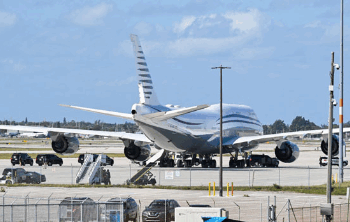The Vatican confirmed on Monday that all 133 eligible cardinals have arrived in Rome ahead of the upcoming conclave set to start this week.
Following the passing of Pope Francis on April 21, the conclave will commence at 4:30 p.m. (1430 GMT) on Wednesday, when the cardinals will enter the Sistine Chapel in seclusion and begin voting in secret until one receives the required two-thirds majority to be elected as the next pope.
The 133 “Princes of the Church” — all under the age of 80, with two absent for health-related reasons — will gather Wednesday afternoon under the iconic frescoes of the Sistine Chapel.
They will vote once on the opening day and four times each day afterward until a decision is made. During this period, they will reside at the Santa Marta guesthouse and are prohibited from communicating with the outside world until the new pope is chosen.
Ballots will be burned after each round of voting, with black smoke signaling no election outcome and white smoke indicating a new pope has been selected.
Earlier on Monday, workers installed red curtains on the balcony of St. Peter’s Basilica, where the newly elected pope will make his first public appearance.
A central question remains whether the new pope will continue the progressive path of the popular Argentine pontiff or take a more traditional direction.
Francis, who served for 12 years, appointed 80 percent of the current voting cardinals. However, analysts caution that this does not necessarily ensure a successor in his mold. Vatican expert Marco Politi described the upcoming election as potentially “the most spectacular in 50 years.”
Cardinals gathered Monday morning for another in a series of preparatory meetings called general congregations, and were scheduled to meet again in the afternoon.
These meetings include all cardinals — not just those voting — and provide a platform for discussing the future challenges the new pope will face.
In St. Peter’s Square, pilgrims and tourists offered mixed views on what direction the Church should take. “Maybe more of Pope Francis than Pope Benedict,” said German visitor Aurelius Lie, 36.
However, Canadian priest Justin Pulikunnel voiced disappointment with Francis’s leadership and called for a more traditional approach. “Well, I hope and I pray that the new pope will kind of be a source of unity in the Church and kind of calm the waters down after almost a dozen years of destabilisation and ambiguity,” he said on Sunday.
The conclave could last several days, weeks, or even months. However, both Pope Francis and his predecessor Benedict XVI were elected within two days.
Top candidates include Italy’s Pietro Parolin, who served as Francis’s secretary of state, and Pierbattista Pizzaballa, the Latin Patriarch of Jerusalem. Also mentioned are Luis Antonio Tagle of the Philippines and Hungarian conservative Peter Erdo.
Nonetheless, many other names are in circulation, and like Francis’s unexpected selection in 2013, the conclave could produce a surprise choice.
Cardinal Louis Raphael Sako of Iraq told reporters that he hopes for “a pastor, a father who preserves the unity of the Church and the integrity of the faith but who also knows the challenges of today.”
He added, “The world is always changing. Every day there is news. The pope must read the signs of the times to have the right answer and not be closeted in his palace.”
What you should know
The conclave to elect Pope Francis’s successor begins Wednesday. With 133 cardinals participating, attention turns to whether the Church will stay on a reformist path or return to conservative leadership. Voting in the Sistine Chapel will continue until one candidate secures a two-thirds majority.
ALSO READ TOP STORIES FROM VERILY NEWS


















